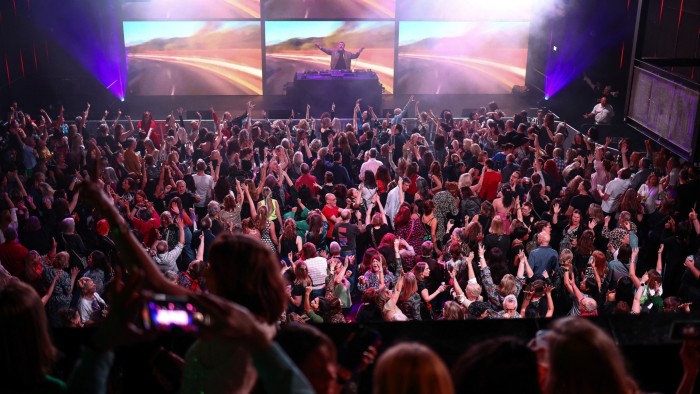Stay informed with free updates
Simply sign up to the Life & Arts myFT Digest — delivered directly to your inbox.
Not for the first time, I am dressed in my finery and standing outside a nightclub, questioning my life choices, blinking into the sunlight.
Luckily for everyone involved, it’s 4.30pm not 4.30am, and I am headed in, not out, of the club. My gaggle of friends and I (all, let’s say, femmes d’un certain âge) dance, drink and wave our hands in the air like we just don’t care. Mission accomplished.
But we’re all out of the club when the lights go on at 9pm and there is still time to get public transport home. I am in bed by 10pm. This is daytime clubbing. It’s a revelation, and I’m a convert.
Daytime clubbing and what is dubbed “light” clubbing — events that end before midnight — provide rare bright spots for what has otherwise been a bleak environment for bars and clubs in the UK. The Gross Value Added — a measure of productivity — of the night-time economy was £43.3bn in 2023, compared with a high of £47.5bn in 2019, according to the Night Time Industries Association, which represents companies operating in the sector.
The reasons for clubbing’s decline are well rehearsed and have accelerated since the pandemic: squeezed consumer finances; higher costs and tighter regulations for venues; and, most intractably, a “vibe shift”, as the kids would have it. The health-conscious young ’uns don’t seem to want to forget that the world is burning down by listening to a series of electro beats in a windowless warehouse with a room full of drunken strangers. No, I don’t know what’s wrong with them either.
The consequences are startling. The number of nightclubs in the UK has plummeted from 1,240 in March 2020 as lockdown began, to 835 at the end of 2024, according to the NTIA quarterly night time economy tracker by CGA Nielsen.
And so it has come to pass that it is down to Gen X — anyone born between 1965 and 1980, neither boomer nor millennial — to do the unsung work and save clubbing. Will our sacrifices never end?
“What we are seeing is that the younger 18-30 crowd want an immersive club experience,” says Michael Kill, who leads the NTIA. “The older crowd just want that feel-good experience and the collective engagement of dancing.”
That back-to-basics approach is, of course, a lot cheaper to run. “It’s true that the [older] clubber is propping up the younger age group, who might not have as much money in their pocket,” he adds.
The problem is that the hedonistic ideal of what Kill diplomatically refers to as “the discerning clubber” collides with the reality of being part of the “sandwich” generation with kids/elderly relatives/pets/high-stress jobs/mortgages to worry about. I believe this used to be known as “middle age”. And that’s hard enough without the hangover, lack of sleep and the existential sense of regret that traditional clubbing until the early hours tends to engender.
For the venues themselves, daytime clubbing makes perfect sense: it uses large buildings that are otherwise redundant during daylight hours. So to save the night-time economy, promoters have just switched to doing the same stuff during daylight hours too. Simple. My learned colleagues in the FT economics team would term this an efficient sweating of idle assets.
Traditional clubs used to use about 13 per cent of their licensed hours. That’s now up to about 30 per cent, Kill explains. “There is an understanding that you have to make it pay to make up for the increase in costs,” he says.
Daytime clubbing is as varied as its night-time counterpart. There are the unabashed cheese-fests, like the one I experienced called Guilty Pleasures. Then there are the underground raves. There are also the more polished events with big-name DJs, such as Annie Mac’s Before Midnight. But all of these are distinct from the clubs (also, confusingly, open in daylight hours) that host “family raves” catering to parents who bring their children. These have their place, of course. But to state the obvious, they also have children.
My hardscrabble reporting on the front line has provided me with some top tips when it comes to daytime clubbing. You can thank me later.
First: lean in, hard. Now is not the time to be too cool for school. Sequins, themed group outfits, leather chaps (or indeed, all three together) are totally appropriate. You will garner nary a second glance within the club, though I can’t vouch for the afternoon approach down the high street. Second: strength in numbers. These are definitely not the events for aloof solo cruising. Third: go early. If you leave it to a time you believe to be more appropriate for clubbing because it’s the hour one might order a gin and tonic in polite society, this is far too late. The dance floor will be rammed with already drunk middle-aged people and it is foolhardy to play catch-up from such a disadvantage. I refer you to the aforementioned kids/elderly relatives/pets/high-stress jobs/mortgages that will still be there in the morning.
But for a few hours, daytime clubbing offers a little respite from all that. Why go big or go home? Now you can go big and go home — all by 10pm.
Email Caroline at [email protected]
Find out about our latest stories first — follow FT Weekend on Instagram and X, and sign up to receive the FT Weekend newsletter every Saturday morning
